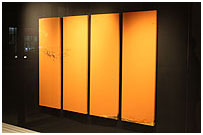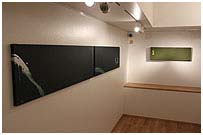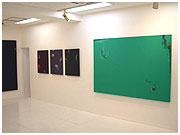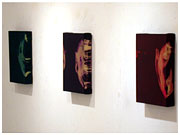論評
| What I Felt From Jun's Paintings | Yoshida Noboru (Animation Art Director) | |
|---|---|---|
| The Spiritual World with Deep Reverberations | Haruo Sanda (Art Journalist) |

It was a strange feeling like the scenery of my remembrance commingled with the present time. My eyes wavered and groped for a color or a shape on the canvas. The first experience of look. The encounter with a painting.
First of all, you can see the monochromatic surface and a form of something which appears slightly when you face his painting from a distance. When you approach to the painting, you feel some forms like something appears everywhere in the calm monochromatic canvas and it become more specifically. While you are trying to elucidate whether it is a concrete form or a abstract form, you would be thrown into an ambiguous middle area. Still looking at the something or the trace of something, some definite scenery in your remembrance appears in your mind. However, it also will fade away like bubbles. Since you can see the touch of paints that was put with the power of brush as substance if you look his painting closely. When you have a distance again, the paints which you saw a little while ago shines quietly in the monochromatic surface and the scenery appears once more.

Jun's works make me the thrilling experience with change caused by the to-and-fro motion to see from a distance and nearby. It may be the first event caused by rather painting than looking a painting. I think Jun can meet with it quietly while he is painting.
-for the exhibition of Jun Ogata's works-
Even in the 21st Century, the traditional technique to draw the real things more beautifully is not lost. If anything, the chance to seeing such a painting is more abundant in daily life. Because the sense of security that might not disturb person's mind is requireed to the decoration in usual life. However, there is no reason to defend the old standard in the expression of art. Because German literature Hans Henny Jahnn says "Even the beautiful thing, the substance is a black of nothingness, a hole pierced by gravitation or an invisible existence for eye and spirit that have seen the contradiction of civilization and the irrational tragedy of war". Therefore, it is not a mirror of the true world though the picture still keeps planarity as of old.

These kind of paintings which are not caught by real world, can be said that they have own spiritual world. Such a painting is exactly what artist Jun Ogata has drawn consistently. A space filled with on color, like black like gross darkness, yellow like tranquil light, green like a dense nature. And a image like a mark of water drop, a shaking flame, a microorganism floating in the water or a twisted human body. Only those two elements are composing a Ogata's screen. Needless to say, the space that does not move and quietly is "Ground" and the image that melts and flows is "Figure".

However, you will feel a some kind of indication filled with deep reverberation from his work which was composed of "Ground" and "Figure". This exhibition is titled "Waon no Kubishi" which are the words not usually used. In my opinion, "Wa" might mean harmony, "On" might mean care and "Kubishi" might mean seriousness and mystery. Therefore, it might be a meaning of the world of spiritual world which was led by his inquiry of the harmony of "Ground" and "Figure". Of course, since "Wa" might mean Japanese style and "On" might mean warmth, it show his characteristic. His work has a deep inspiration like the Oriental painting rather than the Western painting which has depth and composition. It reminds me of an aesthetic sense of the old tanka(syllable Japanese poem) by Noriko Naishinno "A sadness of the dream of deep night does not disappear even if awaking at quiet daybreak".







